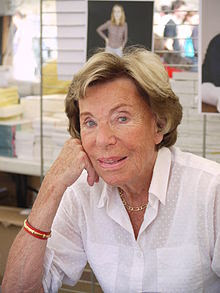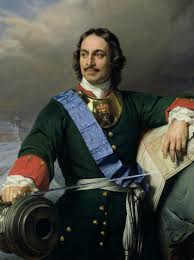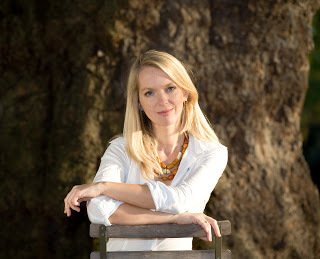Mary Anne Yarde's Blog: The Coffee Pot Book Club , page 83
July 13, 2020
Join me in conversation with #HistoricalFiction author, Susan Lanigan ##WW1 #opera @susanl_author

A Conversation with Historical Fiction author, Susan Lanigan
Please give a warm Coffee Pot welcome to historical fiction author, Susan Lanigan.
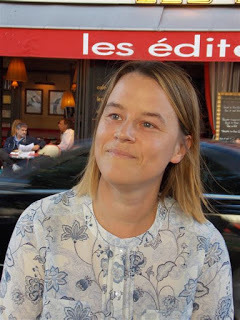
Mary Anne: A huge congratulations on your fabulous new release, Lucia's War. Could you tell us a little about your book and what inspired you to write it?
Susan Lanigan: Lucia was already a character in my previous novel, White Feathers, but most of her story had to be omitted for length. Ever since then I have felt I owe her a book of her own, and that it would be worth the effort to tell her story. It took me a few years and a lot of personal investment, but it was worth the effort!
Mary Anne: What drew you towards the era in which you set your book?
Susan Lanigan: I’m fascinated by World War One, BY the clash of traditional morals with emerging nihilism and liberation - all the more so since the Marketing Department (or whoever makes the call about these things) has decided that since the centenary years are over, nobody cares about that period any more. (Or at least they did until the advent of Covid-19. 1918 and 1919 are receiving renewed interest in its wake.) The Great War – the Bangarang, as Lucia calls it - is such a horror show, and has such massive social ramifications, that you could be telling stories about it for years but still as Sassoon puts it, the singing would still never be done. Since Lucia yearns to be a classical singer, this analogy would resonate with her!
Mary Anne: What were the challenges you faced in researching this period of history and were there any unexpected surprises?
Susan Lanigan: Because Lucia is a Black Jamaican woman, I was writing out of culture, so I had an expert reader as well as an editor check that historically the story was plausible. I thought I’d got some idea of Jamaican dialect but I had lots of gaps in my knowledge. Thankfully, the process was not as daunting as you might think from reading social media – I have to say I found it fun, and an interesting learning experience. All you need is an open mind.
Mary Anne: What do you think is the most challenging aspect of writing Historical Fiction?
Susan Lanigan: I find detail regarding clothing or surroundings tricky – I try to make sure my characters are grounded in the time period, but I find description sometimes tough because I’m an aural more than a visual person. However, I’ve got favourable reviews saying they particularly like that my books aren’t weighed down with research, so maybe I have the balance just right!
For Lucia’s War, I found people who resembled the main characters in my head – and many of the minor characters, Edgar Manning, for example – were real people, so that helped.
Mary Anne: What advice do you have for aspiring Historical Fiction authors?
Susan Lanigan: I think you have to be very engrossed in the period. Even in school I was writing essays about the clustershow that was the Battle of Verdun, so I was obviously intrigued by WWI for a long time. For my first novel, White Feathers, I was entranced by the use of a symbol of peace to perpetuate such a divisive mentality as accusing men of cowardice, and how feminism was put on its head. With Lucia’s War, my love of music was something that permeated the pages.
For writing: Use the real events as waymarks in the first draft if you feel lost. If a battle definitely occurs on x date, so that gives you something to plan towards if your story is getting lost.
Lucia's War
By Susan Lanigan
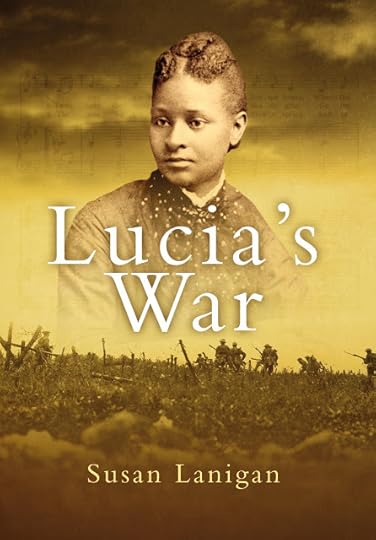
London, 1950.
Soprano Lucia Percival has overcome racism and many obstacles to become a renowned opera singer. She is now due to perform her last concert. But she has no intention of going onstage. A terrible secret from her service during the First World War has finally caught up with her.
London, 1917. Lucia, a young Jamaican exile, hopes to make it as a musician. But she is haunted by a tragic separation that is still fresh in her memory - and when she meets Lilian, an old woman damaged by a similar wartime loss, she agrees to a pact that could destroy everything she has fought so hard to achieve.
From the Western Front and the mean streets of Glasgow, to black society in London, Lucia’s story tells a tale of music, motherhood, loss and redemption.
From the author of "stirring" wartime saga White Feathers, shortlisted for the Romantic Novel of the Year Award 2015, Lucia's War is ideal for fans of Andrea Levy and Sebastian Faulks.
The Coffee Pot Book Club
★★★★★
Highly Recommended
Read the full review HERE!

Pick up your copy of
Lucia's War
Add Lucia's War to your ‘to-read’ list on

Susan Lanigan
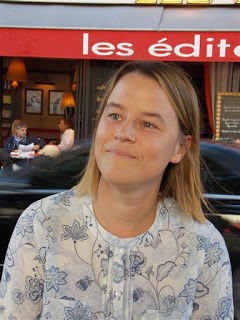
I graduated from Trinity College Dublin with a degree in English and History, then pursued a Graduate Diploma in I.T. in Dublin City University and a Masters in Writing in NUI Galway.
My first novel, White Feathers, a tale of passion, betrayal and war, was selected as one of the final ten in the Irish Writers Centre Novel Fair, 2013, and published in 2014 by Brandon Books. The book won critical acclaim and was shortlisted for the UK Romantic Novel of the Year Award in 2015. My second novel, Lucia’s War, is out now and has been awarded the Indie Books We Love badge from LoveReading.co.uk.
I live by the sea near Cork, Ireland, where I go for walks, get more involved in politics than I bargained for, and continue to work as a software developer.
Connect with Susan:
#BookReview — No Stone Unturned (The Lucy Lawrence Mysteries Series) by Pam Lecky #HistoricalFiction #VictorianMystery @pamlecky

No Stone Unturned
(The Lucy Lawrence Mysteries Series)
By Pam Lecky

A suspicious death, stolen gems and an unclaimed reward: who will be the victor in a deadly game of cat and mouse?
London October 1886
Trapped in a troubled marriage, Lucy Lawrence is ripe for an adventure. But when she meets the enigmatic Phineas Stone, over the body of her husband in the mortuary, her world begins to fall apart.
When her late husband’s secrets spill from the grave, and her life is threatened by the leader of London’s most notorious gang, Lucy must find the strength to rise to the challenge. But who can she trust and how is she to stay out of the murderous clutches of London’s most dangerous criminal?

“Well, this is wonderful news. I almost feel honoured. I have a master criminal and a disgruntled Kashmiri maharajah to fend off. How exciting my life has become!”
Had it only been this morning since Lucy Lawrence had bemoaned her lonely existence and had longed for adventure? But when a constable from Vine Street Station had knocked on her door, life as Lucy knew it would be irrevocable changed forever.
Lucy had so desperately hoped she could rekindle the spark between herself and her husband, Charles. But now it was too late. Too late for Charles and too late for her. As she tries to come to terms with her tragic loss, Lucy receives an unexpected visit. It is a visit that makes Lucy question if she ever really knew her husband at all…
From a knock on the door to a desperate flight through London to see justice served, No Stone Unturned (The Lucy Lawrence Mysteries Series) by Pam Lecky is, in all ways, a historical mystery triumph.
So often historical mysteries follow a male protagonist, therefore I was very excited to discover that Lecky had bucked the trend and given her readers a female lead character. I was immediately drawn to Lucy. She is this wonderfully brave young woman who would not be swayed nor coerced into doing something she did not want to do. However, in her moment of weakness, Lucy turns to her family for support and yet what she receives is nothing short of horrifying. Lucy soon realises that if she has any hope of finding peace, both emotionally and physically, then she must take her life into her own hands. I thought Lucy’s depiction was sublime. Here is a heroine who is used so badly by both her husband and her family, and yet she does not let herself become bitter. She is a very determined young woman who is desperate to solve the mystery of her husband’s death and the puzzle of the stolen jewels. Lecky has done a wonderful job in giving her readers a heroine who they can really get behind and root for.
Phineas Stone is a character that intrigued me. He is astute, intelligent, and more importantly, morally accountable. Lecky does give us a tantalising glimpse into his backstory, and for a self-assured man, it was interesting to witness a different side to him — a vulnerable side. I thought Stone’s depiction was absolutely fabulous.
Lucy, despite being the daughter of a wealthy aristocrat, and living in the 19th century, is remarkably intuitive. I thought it was an inspired idea by Lecky to tell this story from Lucy’s perspective. Lecky allows the reader to solve the mystery along with Lucy, which helps to make this book an addictive and compelling read. Also, Stone, being a specialist investigator, is working on several cases at once, and it would have made for a somewhat disjointed story if Lecky had decided to write from his perspective as well. There is a hint of romance between the two protagonists, but this not a romance book. It is very much a historical mystery with authentic, historically depicted characters.
One of the themes that runs through Arthur Conan Doyle’s Sherlock Holmes adventures is that of the utter incompetence of the police force. Lecky has come away from that stereotypical portrayal to an extent, although not completely. The officers at Vine Street Station are relatively competent, and they work alongside Stone to help bring criminals to justice. However, the police in Yorkshire seem rather colloquial and are almost beholding to the aristocracy who live in their area. They lack proper investigational skills and come across as utterly inept while they try to appease the anxieties of the elite. Stone, coming from a wealthy background, is, therefore, quite a contradiction. He seeks only justice and is not cowed by members of his class. However, there is an incident where one of the perpetrators does not have to account for her crimes simply because she is old and from the aristocracy. I could not help but wonder if the same consideration would have occurred for someone with a lower social standing.
This book vividly demonstrates the cultural milieu of the era. There may well have been a woman on the throne of England, but it was still very much a man’s world where the aristocracy was swimming, and in some cases drowning, in their own self-important and privileged existence. Lecky clearly demonstrates the social divide by depicting the haves and the have-nots throughout this novel. Although there are antagonists on both ends of the social spectrum, it is the cruel manipulation from members of her own family that disturbs Lucy, and the reader, the most. This sense of power stops some members of the Somerville family from seeing a situation objectively. Instead of acting with rational thought, they choose to place the burden of their own failures upon someone else’s shoulders. Their lack of shame, and even reproach at their intended victim when their plans are thwarted, only goes to show the narcissistic nature of their characters as well as the time in which this book is set in. I thought the aristocratic antagonists in this novel were particularly well-drawn. Lecky has captured the very essence of the privileged class, and although Lecky does not tar them all with the same brush, there is a sense that her characters all feel personally entitled to some extent, including our brave protagonist because although Lucy is facing financial hardship, she is not entirely without means.
The aristocracy is not the only social class that Lecky explores. The dangerous London criminal underworld is also portrayed with a striking realism which made for a very chilling plot. With characters such as Nathaniel Marsh, Lecky allows her readers to glimpse into a world that is as dark as it is treacherous. Marsh’s threatening demeanour and his arrogance at thinking he is above the law is played out with a sinister authenticity. Marsh was a character who really made my skin crawl — he is as calculated as he is cruel, and he did not need to be present for his presence to be felt. Marsh has the resources and connections to make life for Lucy very unpleasant indeed. Yet, he is also canny enough to seemingly always be one step ahead of the police.
The historical detailing in this book is as luxurious as it is vibrant. Lecky gives her readers a vivid sense of time and place. The hours of research that has gone into the novel has to be commended. Lecky has used that research and produced a story that is ringing with historical legitimacy.
With an enthralling narrative, No Stone Unturned (The Lucy Lawrence Mysteries Series) by Pam Lecky is a novel that commanded my attention from the very first sentence to that final full-stop. This is a novel that is deserving to be read over and over again. I am certainly looking forward to reading the other books in this series.
I Highly Recommend.
Review by Mary Anne Yarde.
The Coffee Pot Book Club.
Pick up your copy of
No Stone Unturned
Pam Lecky

Pam Lecky is an Irish historical fiction author, writing crime, mystery, romance and the supernatural. Pam is represented by the Hardman & Swainson Literary Agency in London. She is a member of the Historical Novel Society and the Society of Authors and has a particular love of the late Victorian era/early 20th Century.
Her debut novel, The Bowes Inheritance, was awarded the B.R.A.G Medallion; shortlisted for the Carousel Aware Prize 2016; and long-listed for the Historical Novel Society 2016 Indie Award.
Her short stories are available in an anthology, entitled Past Imperfect, which was published in April 2018.
June 2019, will see the release of the first book in the Lucy Lawrence Mystery series, No Stone Unturned, a fast-paced Victorian mystery/crime, set in London and Yorkshire. The sequel, Footprints in the Sand will be released later this year.
Connect with Pam: Website • Amazon • Facebook • Twitter • Instagram
July 12, 2020
Check out Christoph Fischer's fabulous book — The Healer (Fraud or Miracle? Book 1) #Thriller #Medical #Supernatural @CFFBooks @WriterCFischer

The Healer
(Fraud or Miracle? Book 1)
By Christoph Fischer

When advertising executive Erica Whittaker is diagnosed with terminal cancer, western medicine fails her. The only hope left for her to survive is controversial healer Arpan. She locates the man whose touch could heal her but finds he has retired from the limelight and refuses to treat her. Erica, consumed by stage four pancreatic cancer, is desperate and desperate people are no longer logical nor are they willing to take no for an answer. Arpan has retired for good reasons. casting more than the shadow of a doubt over his abilities. So begins a journey that will challenge them both as the past threatens to catch up with him as much as with her. Can he really heal her? Can she trust him with her life? And will they both achieve what they set out to do before running out of time?
Praise for The Healer (Fraud or Miracle? Book 1)
“Touching thriller that raises many profound questions”
Katie
“…a wonderful insight into the world of alternative healing and the conflict between holistic medicine and Western medicine”
Deborah A. Bowman
“A psychologically astute book that will make you think about your own mortality. And what an ending!”
Olga NM
Excerpt
The tired, small hatchback hit a rock next to the edge of the road and came to an unexpected and abrupt stop. Erica had not seen the bulky thing hidden underneath the uncut grass. She switched off the engine and got out. There seemed no significant damage to her old banger but she couldn’t care less right now, to be honest, and decided she would leave it parked here anyway. She must be close.
Quite frankly, she considered herself lucky to have made it this far; the roads had been bumpy and her car was in a dire condition, too. It wouldn’t be much longer before it would have to be scrapped. Living in London she rarely needed it and had often been tempted to sell it anyway.
This was deepest Wales, the countryside – something that the Londoner in her had not seen for years and certainly hadn’t missed. Poor phone reception, miles to the nearest supermarket with its supplies of cigarettes and bubbly: that’s what the countryside meant to her.
She guessed the car was sufficiently off the road and out of the way. Who would come here, anyway? It was unlikely that two cars would find this remote corner of Wales at the same time, she reckoned. Erica looked around: not a living soul in sight, no houses or vehicles; she was totally off the beaten track. She could see no significant landmarks; all views were blocked by large trees and hedges. It was drizzling a little and although it was past lunchtime, there was mist that reminded her of early mornings. The wind had made the spring temperatures drop more than she had anticipated and she was chilly in her inadequate city clothing.
She searched her purse for the map, which her assistant Hilda had drawn for her. It seemed as if she was in the right place; there was the small path at the foot of the hill, and the two opposing gates leading to fields with horses and sheep. Since leaving her nearby B&B, all the road junctions she had come to had been easy to recognise and here was the little shoulder by the side of the road, where Hilda had recommended she should park the car.
She assured herself once more that it was the right path and then she psyched herself up for the walk up the steep hill. The tricky part, Hilda had explained, was finding the hidden gate, which would lead her to the man himself. However, Hilda didn’t have pancreatic cancer and was not recovering from a course of chemo and so she had no idea how difficult it would be for Erica to walk up that hill. It seemed by no means the easy climb her assistant had called it. For all her recent goodness, that woman could drive her mad.
Erica looked at herself in the outside mirror of her car before getting ready to face the man. Her hair had not fallen out from the chemo but it had turned grey and made her look much older than she was. There were still crow’s feet and wrinkles despite being facially bloated – it really wasn’t fair; the worst of both worlds. People used to think of Erica as at least five years younger than she actually was, but now people thought she was five years older. Overnight it seemed, she had aged from 40 to 50 but given her current situation she would be lucky to reach 45. Additionally, she had lost a lot of weight, despite the effect that the steroids had had on her. With her mere 5’ 4’’ frame, she looked tiny and felt thin and weak.
Only this man might be able to improve her chances and she desperately hoped the trip here would be worth it. If the man really was who Hilda thought, there was a slight chance for her. If she could make him speak to her, then she was sure she could persuade him to help – if he still possessed those powers. There suddenly seemed a lot of ifs.
Pick up your copy of
The Healer
Also available on Audio
Christoph Fischer
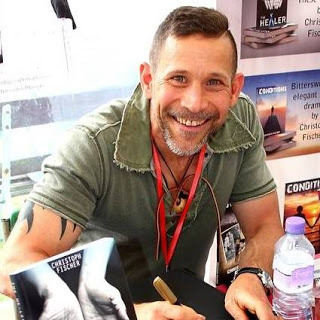
USA Today and Amazon No 1 bestselling author Christoph Fischer was born in Germany as the son of a Sudeten-German father and a Bavarian mother. Not a full local in the eyes and ears of his peers he developed an ambiguous sense of belonging and home in Bavaria. He moved to Hamburg in pursuit of his studies and to lead a life of literary indulgence. He now lives in a small town in West Wales with his husband and three Labradoodles.
Christoph worked for the British Film Institute, in Libraries, Museums and for an airline.
'The Luck of The Weissensteiners', the first of 5 historical novels was downloaded over 100,000 times on Amazon and reached No in Historical Fiction. "Time to Let Go", his first contemporary work was published in May 2014.
His medical thriller "The Healer" was released in January 2015 and reached No 1 in medical thriller category on Amazon and became a USA Today bestseller in 2019. Other popular books of his are "Ludwika” and "Murder at Eurovision" , the second in his Bebe Bollinger cozy mystery series.
Connect with Christopher: Blog • Twitter • Facebook • Goodreads • Amazon Author Page.

July 10, 2020
Historical Fiction author, Ellen Alpsten, is talking about the inspiration behind her fabulous book — Tsarina #HistoricalFiction #Russia @EAlpsten_Author
An Author’s Inspiration
By Ellen Alpsten
As a student in Paris I worked as an assistant to the bestselling author Benoite Groult: her novel ‘Salt on my skin’ was a 90’s smash hit and she was a Parisian writer through and through: smoking like a chimney, wafting about in a huge ‘enfilade’ 7th arrondissement apartment, wearing oversized horn-rimmed glasses. She gave me some valuable advice - be serious about your writing!
When I joined a Graduate Trainee Scheme in a big London PR agency, I hardly earned any money and I knew very few people: every evening, I sat and wrote. There is no excuse– if a story sears your soul, tell it! ‘Tsarina’ certainly was such a story: Catherine I of Russia – NOT Catherine the Great – rose from serf to Empress, while the country morphed from backward nation to beginnings of a superpower.

“Tsarina” is the most extraordinary rags-to-riches tale – of sex, power and ruthlessness - but also the story of the birth of modern Russia, of a rising Empire in turmoil and change, of the madness of war, the reckless brutality of absolute monarchy set against the colourful backdrop of the wild and passionate world of 18th century Russia, where nothing is as abundant and worthless as human life.
I came across ‘Tsarina’ when aged 13, reading ‘Germans and Russians’, which charted the millennial history of those two people, who despite two horrendous wars share a deep, mutual fascination. When I had matured to REALLY write, I realised that, incredibly, there was no book about her: no thesis, no biography, no novel. Nothing! Like Tut-Ankh-Amun, she had always been there, but the Tsars before and after shed so much light, that she slipped into the shadows.
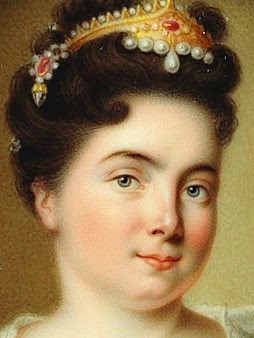
So, I got serious: I read for a year, until I felt ready describe her strange, sensuous, and shocking world, writing the opening sentence. My research ranged from watching experimental movies such as ‘Russian Ark’ to immersing myself into a 17th century German merchants Russian travel diaries and understanding the imaginary of Slavic fairy tales. By then, I wrote after my work as an anchor on breakfast TV - an incredibly stringent exercise: I got up at 2 am, was home by noon, napped, went for a run, wrote until 9pm, sleep, repeat. If ‘Tsarina’ is a piece of literary diplomacy, making more people understand Russia, I at times, felt overwhelmed by the sheer size of this technicolour tale – half a dozen books at least lay open next to my PC while writing.
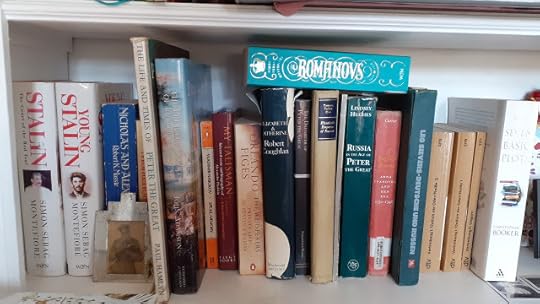
‘Tsarina’s early days are shrouded in mystery, so Benoite Groult’s second advice came handy:
‘A protagonist has to sink low until we are happy for him/her to rise’.
History is not only about Kings and Queens. ‘Tsarina’s story is as contrasting as the Russian Soul itself, casually combining seemingly insurmountable opposites: callous cruelty and overwhelming empathy; overt hostility towards all things foreign, yet selfless hospitality to strangers; freezing, interminable winters - zima –, and the balmy summers’ white nights. She grew up in an izba, a rickety hut; she suffered every humiliation imaginable and lost her Baltic homeland, finding a new home in the Tsar’s heart. How? Every girl needs her secrets. Just so much: if Peter LOVED turning the world upside down, she certainly exceeded any brief, politically setting the scene for an unprecedented century of female reign in Russia.
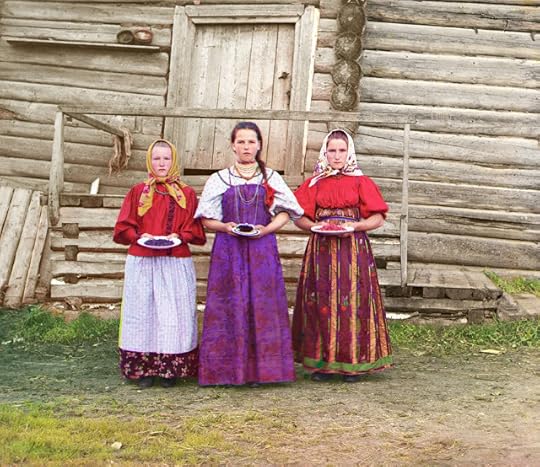
So, there is a third advice: Keep going! The more I write, the more I see how hard it is on how many levels to write an accomplished novel. Finishing is a fantastic achievement, but the first draft is a drop in the ocean. Editing is schizophrenic - knowing the text by heart, but having to read it completely afresh, each time, many times: in the case of ‘Tsarina’, about 300 pages got the cull! Published today is the possibly 30th version of the manuscript; an early draft comparing to the first 1886 Mercedes Benz; the final book to a Bugatti Chiron. It is a writer’s responsibility to do his/her best – we owe that to the readers, who gives us their time, an ever-diminishing resource.

Do not ever give up. Getting published traditionally is artistically the hardest challenge. You look at a painting in one second. You listen to a song in three minutes. But convincing someone to read your 628-page tome about a forgotten Russian Empress? Hang in there. Nowadays, there are so many different, new ways to getting published, thanks to modern technology – promise to explore them all. So, finally: Follow your dream!
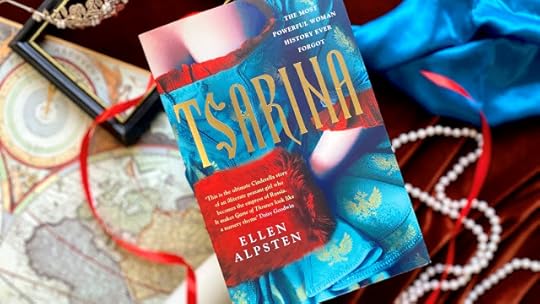
Tsarina
By Ellen Alpsten

Spring 1699
Illegitimate, destitute and strikingly beautiful, Marta has survived the brutal Russian winter in her remote Baltic village. Sold by her family into household labour at the age of fifteen, Marta survives by committing a crime that will force her to go on the run. A world away, Russia's young ruler, Tsar Peter I, passionate and iron-willed, has a vision for transforming the traditionalist Tsardom of Russia into a modern, Western empire. Countless lives will be lost in the process. Falling prey to the Great Northern War, Marta cheats death at every turn, finding work as a washerwoman at a battle camp. One night at a celebration, she encounters Peter the Great. Relying on her wits and her formidable courage, and fuelled by ambition, desire and the sheer will to live, Marta will become Catherine I of Russia. But her rise to the top is ridden with peril; how long will she survive the machinations of Peter's court, and more importantly, Peter himself?
Praise for Tsarina
"Makes Game of Thrones look like a nursery rhyme..."
Daisy Goodwin
"Alpsten's colourful narrative does full justice to her extraordinary career..."
Sunday Times
"A vivid page-turner of a debut..."
The Times
Excerpt
Prologue
In the Winter Palace, 1725
He is dead. My beloved husband, the mighty Tsar of all the Russias, has died – and just in time. Moments before death came for him, Peter called for a quill and paper to be brought to him in his bed-chamber in the Winter Palace. My heart almost stalled. He had not forgotten, but was going to drag me down with him. When he lost consciousness for the last time and the darkness drew him closer to its heart, the quill slipped from his fingers. Black ink spattered the soiled sheets; time held its breath. What had the Tsar wanted to settle with that last effort of his tremendous spirit? I knew the answer.
The candles in the tall candelabra filled the room with a heavy scent and an unsteady light; their glow made shadows reel in corners and brought the woven figurines on the Flemish tapestries to life, their course faces showing pain and disbelief. Outside the door, the voices of the people who’d stood there all night were drowned out by the February wind rattling furiously at the shutters. Time spread slowly, like oil on water. Peter had pressed himself into our souls like his signet ring in hot wax. It seemed impossible that the world hadn’t careened to a half at his passing. My husband, the greatest will ever to impose itself on Russia, had been more than our ruler. He had been our fate. He was still mine.
The doctors – Blumentrost, Paulsen and Horn – stood silently around Peter’s bed, staring at him, brow beaten. Five kopeks-worth of medicine, given early enough, could have saved him. Thank god for the quacks’ lack of good sense.
Without looking, I could feel Feofan Prokopovich, the Archbishop of Novgorod, and Alexander Menshikov watching me. Prokopovich had made the Tsar’s will eternal and Peter had much to thank him for. Menshikov, on the other hand, owed his fortune and influence to Peter. What was it Peter had said when someone tried to blacken Alexander Danilovich’s name to him by referring to his murky business dealings? ‘Menshikov is always Menshikov, in all that he does!’ That had put an end to that.
Dr Paulsen had closed the Tsar’s eyes and crossed his hands on his breast, but he hadn’t removed the scroll, Peter’s last will and testament, from his grasp. Those hands, which were always too dainty for the tall, powerful body, had grown still, helpless. Just two weeks earlier he had plunged those very hands into my hair, winding it round his fingers, inhaling the scent of rose water and sandalwood. ‘My Catherine’ he’d said, calling me by the name he himself had given me, and he smiled at me. ‘You’re still a beauty. But what will you look like in a convent, shorn, and bald? The cold there will break you, your spirit, even though you’re strong as a horse. Do you know that Evdokia still writes to me begging for a second fur, poor thing! What a good job you can’t write!’ he’d said, laughing.
It had been thirty years since Evdokia had been banished to the convent. I’d met her once. Her eyes shone with madness, her shaven head was covered in boils and scabs from the cold and the filth, and her only company was a hunchbacked dwarf to serve her in her cell. Peter had ordered the poor creature have her tongue cut out, so in response to Evdokia’s moaning and laments, all she was able to do was burble. He’d been right to believe that seeing Evdokia would fill me with lifelong dread. I knelt at Peter’s bedside and the three doctors retreated to the twilight at the edge of the room, like crows driven from a field: the birds Peter had been so terrified of in the last years of his life. The Tsar had called open season on the hapless birds all over his Empire. Farmers caught, killed, plucked and roasted them for reward. None of this helped Peter: silently, at night, the bird would slip through the padded walls and locked doors of his bedchamber. Its ebony wings blotted the light and in their cool shadow, the blood on the Tsar’s hands never dried. His fingers were not yet those of a corpse, but soft, and still warm. For a moment, the fear and anger of these past few months slipped from my heart like a thief in the night. I kissed his hands and breathed in his familiar scent of tobacco, ink, leather, and the perfume tincture that was blended for his sole use in Grasse.
I took the scroll from his hand, it was easy enough to slide it out, although my blood thickened with fear and my veins were coated with frost and rime like branches in our Baltic winter. It was important to show everyone that I alone was entitled to do this – I, his wife, and the mother of his children. Twelve times I had given birth. The paper rustled as I unrolled it. Not for the first time, I was ashamed of my inability to read and I handed his last will to Feofan Prokopovich. At least Menshikov was as ignorant as I. Ever since the days when Peter first drew us into his orbit and cast his spell upon us, we had been like two children squabbling over their father’s love and attention. Batjushka Tsar, his people called him. Our little father Tsar.
Prokopovich must have known what Peter had in mind for me. He was an old fox with a sharp wit, as comfortable in heavenly and earthly realms. Daria had once sworn that he had 3,000 books in his library. What, if you please, can one man do with 3,000 books? The scroll sat lightly in his liver-spotted hands now. After all, he himself had helped Peter draft the decree that shocked us all. The Tsar had set aside every custom, every law: he wanted to appoint his own successor and would rather leave his empire to a worthy stranger over an own, unworthy child.
Pick up your copy of
Tsarina
Amazon UK • Amazon US • Bloomsbury • Waterstones • Indie-Bookshops
Ellen Alpsten
Ellen Alpsten was born and raised in the Kenyan highlands, where she dressed up her many pets and forced them to listen to her stories.
Upon graduating from the 'Institut d'Etudes Politiques de Paris', she worked as a news-anchor for Bloomberg TV London. While working gruesome night shifts on breakfast TV, she started to write in earnest, every day, after work, a nap and a run. So much for burning midnight oil!
Today, Ellen works as an author and as a journalist for international publications such as Vogue, Standpoint, and CN Traveller. She lives in London with her husband, three sons, and a moody fox red Labrador.
'Tsarina' is her debut novel.
For more information about her literary life follow her on social media:
Website • Instagram • Facebook
July 9, 2020
Check out Johanna Wittenberg's fabulous #NewRelease — The Falcon Queen: The Norsewomen Book 2 #Scandinavian #HistoricalFiction @JoWit5

The Falcon Queen
The Norsewomen Book 2
By Johanna Wittenberg

Åsa has won her father’s kingdom, but can she hold it?
The evil shapeshifter Hrolf lurks in the hinterlands, plotting revenge. The powerful Danes threaten from across the Skagerrak Sea, demanding marriage in exchange for peace, while her only ally, Olaf, presses his own suit. Though she loves Olaf, Åsa refuses to sacrifice her position and her people’s welfare to become any man’s property.
Across the snow-clad mountains comes Ragnhild, a runaway shield-maiden, seeking glory and gold. She seems to be the answer to Åsa’s prayers, but Ragnhild’s past catches up with her, bringing treachery and war.
Pick up your copy of
The Falcon Queen
Catch up with the series…

The Norse Queen
The Norsewomen Book 1
By Johanna Wittenberg

Ninth-century Norway -- a land shattered into thirty warring kingdoms, where a woman can seize power, if she is bold enough.
Daughter of a Norse king, fifteen-year-old Åsa prefers swordplay to needlework and dreams of becoming a shield-maiden. When she spurns a powerful warlord, he attacks, killing her father and brother and taking her captive. To save her surviving people, Åsa must wed the murderer. To wreak vengeance, she must bide her time while secretly mastering the warrior’s craft and the dark mysteries of sorcery.
Praise for The Norse Queen
“A journey back into the heart and soul of ancient Viking realms. Queen Åsa of Tromøy, a true historical figure almost lost in the mists of time, returns to vivid life in “The Norse Queen.” Step inside a Scandinavian saga in all its richness. If you love “Beowulf” you will also love “The Norse Queen.”
Margaret George, NY Times Bestselling Author
“The Norse Queen brims with action in a world both exhilarating and terrifying, peopled with sorceresses, warring jarls, and even shape-shifters. In its tale of one woman’s steadfast courage in the face of tragedy, it gives life and breath to a long-forgotten 9th century queen.”
Patricia Bracewell, Author of Shadow on the Crown and The Price of Blood
Pick up your copy of
The Norse Queen
Johanna Wittenberg

Like her Viking forebears, Johanna Wittenberg has sailed to the far reaches of the world. She lives on a fjord in the Pacific Northwest with her husband, whom she met on a ship bound for Antarctica. For fascinating facts about the Viking Age, visit Johanna’s website Here!
Connect with Johanna: Website • Facebook • Twitter • Goodreads • BookBub.
Join #HistoricalFiction author, Vivienne Brereton, as she takes a look at the magic of portraits #History #Art #Tudors @VivienneBreret1

The magic of portraits - every picture tells a story.
By Vivienne Brereton
When I set out to write my historical series, ‘The House of the Red Duke’, set against the background of four European courts (Tudor, Stewart, Valois, and Habsburg) I decided to use all five (or six!) senses in my research. With that in mind, art galleries were firmly on my visual list, along with TV series, movies, historic houses, and magnificent gardens. Today, I’ve selected three characters that appear in my books: the Valois king: François I, and the famous Boleyn sisters (or Bullens as I call them): Mary and Anne. And a few of the paintings associated with them.
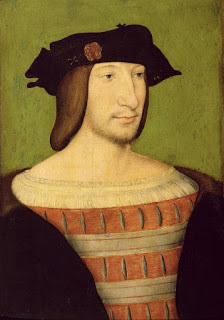 I think the first time I realized that portraits could be a way of connecting with the past for me was when I stood in front of one of François I of France in the Condé museum, located in the Château de Chantilly. Of course, in my research I’d looked at the portrait many times in books but this time it was completely different. The page in the book made the portrait seem flat, dull, and lifeless.
I think the first time I realized that portraits could be a way of connecting with the past for me was when I stood in front of one of François I of France in the Condé museum, located in the Château de Chantilly. Of course, in my research I’d looked at the portrait many times in books but this time it was completely different. The page in the book made the portrait seem flat, dull, and lifeless.
The reality was totally different, as if the personality of the sitter had somehow lingered in the oils used by the painter. Instead of a face that Desmond Seward, the historian, once described as (in a woman) ‘belle laide’, it was as if I was standing in front of a colour photograph or a video recording, leading me straight back to Jean Clouet and his illustrious sitter in 1515. When I looked at the same portrait in a book, I saw a strong, interesting face with a very long nose; close-up, the most remarkable thing was François’s incredible sense of humour, teasing me as if he knew I was looking at him. Right then and there, it changed my whole view of the King of France, called ‘the sun king of the sixteenth century’ by Seward. The laughter in his dancing brown eyes bubbled up from within and I left the gallery knowing I’d found my man. From there on, it was easy to incorporate him into my novel, using that humour always lurking near the surface.
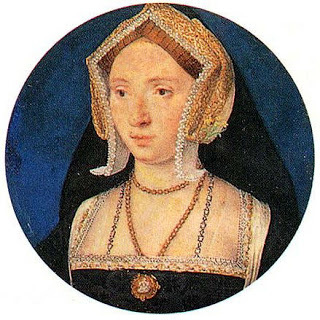
While I was doing my research, this was a possible portrait of Mary Boleyn by Lucas Horenbout, entitled ‘Miniature of an unknown woman’. As with Mary’s sister, Anne, there were several portrait versions claiming to be a true likeness. At the time, I looked at all of them and decided this one best matched the Mary I was describing in my novel. But still not really how I imagined her. Too sad, too serious. The ‘unknown woman’ was twenty-five which corresponded with Mary’s age; in 1525, Mary had been married to William Carey for five years and, as mistress to Henry, possibly borne the King two children.
In my mind’s eye, Mary had a pretty sensual face, and a self-assurance that won her the admiration of two European kings: François I of France, and Henry Tudor of England. When I was writing, unlike Anne, who was very difficult to capture, Mary came racing across the pages with a zest for life and a sense of mischief and fun I imagined she possessed at the time. She didn’t leave her relationship with Henry rich and set up for life (even though her husband received favours). In fact, when William Carey died of the sweating sickness in June, 1528, and her sister was already high in the King’s affections, Mary became so impoverished that she took to begging at court for money. Instead of making a prestigious second marriage, approved of by Anne and Henry, in 1534, Mary caused a scandal by finding love with a soldier of lower birth and turning up at court obviously pregnant. Anne was outraged and perhaps more than a little jealous that Mary had found true happiness, and possessed easy fertility, when both continued to elude her. There is an irony that the eldest of the three Boleyn children, and to outward appearances, the least successful, she alone survived to middle age and died peacefully in her own bed.
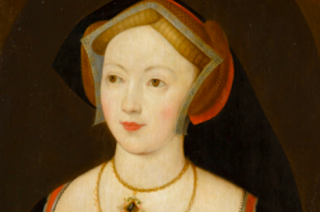
So, imagine my excitement when in 2020, after the publication last year of ‘A Phoenix Rising’, Book One of ‘The House of the Red Duke’, a new version of Mary was unearthed. I haven’t yet had the chance to stand in front of this ‘newly discovered’ portrait of Mary, with her distinctive cupid’s bow mouth: a painting that had been hanging anonymously in Mary Queen of Scot’s bedchamber in Holyrood Palace in Edinburgh. A team from the Jordaens Van Dyck Panel Paintings Project finally decided, after extensive research, that they had found their woman. If I compare the two portraits of Mary, there is no doubt in my mind which one I would choose. And which one fits the description of my own Mary.
Anne Boleyn has been my most elusive character to pin down and where
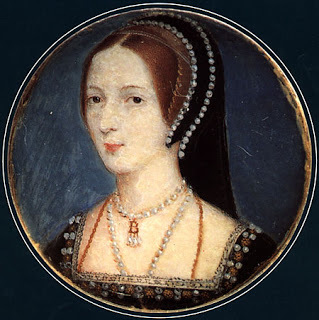
portraits are concerned, controversy still rages about what she actually looked like. The portrait most associated with her (in the National Portrait Gallery, London) depicts a thin, hard-faced woman with pointed features, surely not one who could capture the heart of a man like Henry Tudor for so long. After much deliberation and a careful study of all the ‘portrait candidates’, I feel the above one of Anne by John Hoskins, a 17th century miniaturist ( who claimed he copied it from an ancient original), appears to be the closest.
Hever Castle was Anne’s childhood home from the age of three and when I stood in her bedroom there, I felt very close to her. Standing in front of a different version of the same portrait (dated 1534), I became aware of a much more sensitive, dreamy woman than the ruthless, almost hysterical one we’re used to reading about. Yet, still one a woman who’d been clever enough to get the best out of a tricky situation.
Life at the Tudor court was notoriously fraught with danger, and although Anne was navigating its waters with a certain aplomb, without a male heir in the cradle, she was far from secure. The woman in front of me had a sadness about her, a disappointed air, knowing that with each humiliating new tryst Henry began, it was a rejection of the great love he’d once had for her. He was also showing her it was time to keep her end of the bargain and produce the son she’d promised him. In the end, despite her courage and intelligence, and fighting to the end to regain Henry’s affections, she remained powerless against the force of his anger.
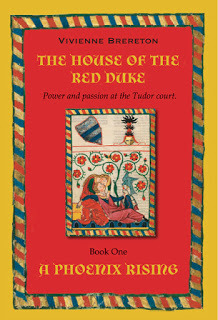
To finish, I’d like to include a passage from ‘The House of the Red Duke’ featuring François. He suddenly appears in the kitchens at La Colombe, near Ardres, in Picardy, where nine-year-old Valentine de Fleury, and her younger sister, Charlotte, are looking at some books on a shelf….
‘Valentine had never bothered to learn the long titles of the two cookery volumes but knew that one had been written more than a hundred years ago.
‘Who wrote that one?’ asked Charlotte, pointing to the book on the left, her brown eyes big with curiosity.
Valentine wasn’t about to let her sister know she had no idea.
‘It was a rich Parisian,’ said a male voice from behind them.
The girls whirled around to come face to face with a youth of about sixteen or seventeen, not far off six feet tall, powerfully built, and dressed entirely in green satin. Although he wasn’t conventionally handsome, his pale oval face with lively hazel eyes (almost the same hue as his shoulder-length hair), his over-long nose, and shapely mouth, together with his fine clothes, made it obvious he’d stepped out of the French court.
‘He was an extremely old man,’ said the boy. ‘He knew a great deal about many topics and decided he was the best person to educate his fifteen-year-old bride. His book is at least three hundred pages long, and besides recipes, has advice for his poor young victim on everything from hawking, and looking after horses…to how to pray.’
‘Are you the King?’ asked Charlotte, to Valentine’s disgust.
She gave her sister a hard nudge. ‘Of course, he isn’t, you jolthead! The King’s very old. So old I don’t even know how old he is.’
The boy in front of them started to laugh. ‘I’m not sure the King would be pleased to hear that.’
‘You’ve got a very long nose,’ said Charlotte in a matter-of-fact voice, as if it was the most natural thing in the world to say to a complete stranger.
Valentine was mortified. <<What’s wrong with Charlotte today? It’s as if some evil sprite has taken control of her tongue>>
Luckily, the boy didn’t seem to mind. ‘Some call me “Foxnose”. Behind my back of course.’
Valentine decided she liked this newcomer with his clever face that reminded her of a satyr - but one always on the brink of laughter. Even so, he was an interloper in the Fleury family kitchens, and as the most important member of the family present, it was up to her to straighten matters out. She put her hands on her hips. ‘Who are you then?’
The boy gave a deep bow, whether to mock or flatter, she couldn’t be certain.
‘May I present myself. François d’Angoulême. Duc de Valois.’

“If I have anything to do with it, we Howards will live forever.”
Thomas Howard Charismatic head of one of the most powerful Houses in Tudor England. An indomitable old man approaching eighty: soldier, courtier, politician, a ‘phoenix’ rising from the ashes. After a calamitous period of disgrace, the Howards, renowned for their good looks and charm, are once more riding high at the court of Henry VIII.
Set against the backdrop of the extraordinary 1520 ‘Field of Cloth of Gold’, it is a tale of ambition, love, and intrigue, with Thomas at the centre of this intricate tapestry
Will Thomas’s bold vow be fulfilled? Danger stalks the corridors of the royal courts of Europe. Uneasy lies the head beneath a crown. Every other ruler - a fickle bedfellow…or sworn enemy.
The action takes place in England, Scotland, and France. On either side of the Narrow Sea, four young lives are interwoven, partly unaware of each other, and certainly oblivious to what Dame Fortune has in store for them.
“Nicolas de La Barre laid his lute to one side, hardly bothering to stifle a yawn of boredom. Nevertheless, he couldn’t escape the fact he’d agreed to take on a new wife….”
Explosive family secrets are concealed behind the ancient walls of castles in three lands. But…
“There are no secrets that time does not reveal.”
Pick up your copy of
Amazon UK • Amazon US
Vivienne Brereton
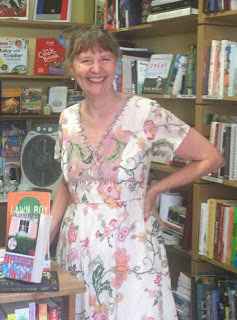
I’ve always loved the Tudor period, from a very early age, have a degree in medieval history. I’ve lived in six different countries in my life and soaked up the history in each one. I now live in France which made writing about three different countries and cultures easier for me. I’ve always worked with words wherever I’ve lived: teaching, editing, writing.
I’m married with three sons so plenty of scope for Nicolas and Tristan! Anne Boleyn was the only character I found slightly elusive. All the others were so vivid, I had no problem getting into their heads. Of the kings, James was my favourite and after all my reading I hope I did him justice. All were brilliant men. Renaissance men, so cultured. What would they make of ours today? Harry could easily pass for Henry’s naughty little brother. Not sure Charles would make the grade.
Connect with Vivienne: Website • Blog • Twitter • Goodreads.
July 8, 2020
Are you looking for a safe and legitimate way to gain interest and reviews for your Book? Let's talk about #NetGalley #bookreviews #bookpromotion @LPOBryan

Let's Talk About NetGalley
 Are you looking for a safe and legitimate way to gain interest and reviews for your Book?
Are you looking for a safe and legitimate way to gain interest and reviews for your Book?Would you like to get your Book in front of Professional Reviewers?
Would you like to use a service that is used by all the major publishing houses?
If so, NetGalley may be the answer.
What is NetGalley?
In their own words:
"NetGalley is a platform that allows publishers to put their books in front of readers of influence. Over 380,000 registered members use the site to find titles to review, books to stock in their stores or libraries, add to educational reading lists or cover in their media activities. If approved to access the title, members can download it securely to any major reading device, and as all files are protected, your content cannot be shared or disseminated. It’s the perfect way to amplify the interest in your titles before, during and after publication."
I have secured a massive 25% discount with Books Go Social's, already very reasonable, NetGalley Promotional Package. This discount makes it very affordable for you to get your book onto NetGalley and in front of those 380,000 registered members.
I would not try to sell you something that I did not believe in. I have used NetGalley, and it allowed me to connect with the most wonderful book bloggers, many of whom are now part of my launch team. For me, it was certainly worth the money.
NetGalley is the #1 service in the world for getting reviews on Amazon — many of the reviewers are Amazon Top Reviewers as well as being influential bloggers.
Who are Books Go Social?

Books Go Social (BGS) is a highly respected Author Promotion service — you may have already heard of them. The founder of BGS, Laurence O’ Bryan is dedicated to helping authors showcase their books. He knows what works and what does not. This is why I am so excited to be working with him on this fantastic deal.
This offer is only available for a very LIMITED TIME. With the 25% discount, this is one of the cheapest ways you can get your book in front of those influential NetGalley Professional Readers.
To get your 25% discount click on:
Books Go Social NetGalley Promotion
and type:
may25
at the checkout.
If you have any questions, then don’t hesitate to ask.
*NetGalley does not restrict to positive only reviews.
Check out Tasha Brown's fabulous book — I Never Left #Paranormal #Ghosts #GreatBooks @EarthAngelTasha
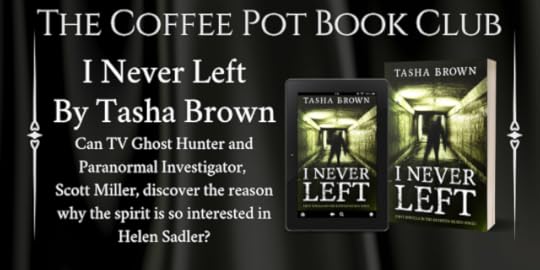
I Never Left
By Tasha Brown
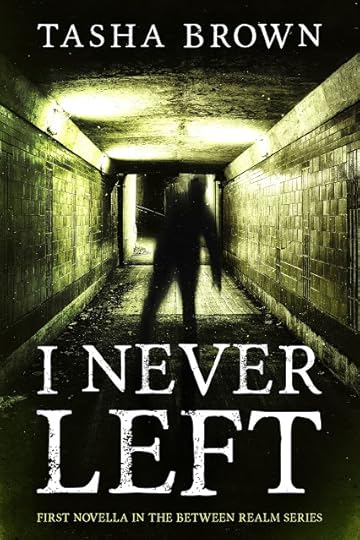
I Never Left by Tasha Brown is the pilot Novella for a new series Between Realms.
Helen Sadler was a victim in a drunk driving accident, it left her with no memories of her life before waking up in the hospital. On returning home she discovers she is haunted. Unsure of just what is happening to her, she enlists the help of TV Ghost Hunter and Paranormal Investigator Scott Miller.
Helen tells Scott that she has witnessed books flying off the shelf, a ghostly apparition and strange light anomalies. Scott is both excited and intrigued by her story, he loves everything paranormal and promises to investigate, but first he wants to get to know his client. A local prison is the first place they visit, just what will the event tell Scott about her?
The mystery of Helen’s home will become a journey of self-discovery. Can Scott discover why the spirit is interested in Helen?
Excerpt
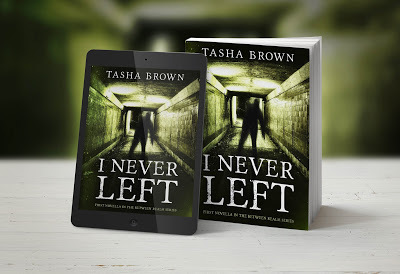
About an arms-length from the staircase, that strange feeling began to crawl across her back, her anxiety crept to the surface, sending her heart racing, her skin flushing with goose bumps. No, she did not like that feeling, it meant something, but she didn’t know what. Helen waited for a gap to descend the stairs, feeling a strong tugging sensation, like someone was pulling at her shoulders. Turning thinking someone was behind she found no one. The fear must have shown on her face because several of the hunters who were stood to her left, suddenly moved, allowing her down. Gripping the railing and thankful they had allowed her to leave, Helen stepped quickly, turning at the bottom and finding Scott holding the door open.
“Is that the way out?”
He barely had time to nod before she raced through. “Let me out!” she gasped. “LET ME OUT!”
Pick up your copy of
I Never Left
Tasha Brown

Tasha Brown lives in the South West of England, she published her first book in 2018. Her new genre choice followed after her own recent paranormal experience, which led her to join a paranormal team on their investigations, all over the country.
Connect with Tasha: Facebook • Twitter • Amazon Author Page.
July 7, 2020
Check out Eliza Tilton's fabulous book — Daughter of the Song (Unholy Magic Saga Book 1) #YA #Paranormal #Fantasy @ElizaTilton

Daughter of the Song
(Unholy Magic Saga Book 1)
By Eliza Tilton

A dark secret. A taboo love. A war upon the living.
After being kidnapped by occultists, Arabella Grace and her family move to the mining town of Port Tablot to forget the horror they experienced in England. With scars adorning her body, Arabella searches for peace by hiding within her songs.
But Port Tablot has its own demons. As the dead leave their domain, a spark of magic awakens within Arabella, and her songs have the power to stop the creatures from hurting anyone she loves, including the quirky boy Leo she's falling for ... if she's willing to make a sacrifice.
With the powerful words of her songs, Arabella must fight the wave of undead and stop the necromancer who's raising them ... or it won't just be her home that falls in to a pit of ghosts.
Start reading the first book in the Unholy Magic Saga and get lost in a YA Paranormal Romance series that takes place in Victorian England and has a gothic twist. Perfect for fans of Victoria Schwab and Holly Black.
Excerpt
Rushing water cascaded on the left of us, drowning out the calls of my brother. To the right, an uneasy breeze filled the darkness. We stood closer, me two heads shorter than him. I turned from Leo, inching toward the dark. The soft flow of wind carried a voice too faint to decipher the words. Leo pulled me back to the light and shook his head.
I wanted to ask about the noise, but I feared my brother’s unearthly hearing would catch us speaking. I mouthed “what” and pointed.
I’d seen fear in men. It tainted the eyes, reflecting a despair that ran through their blood to crucify their soul. I saw the same dread in Father’s eyes when he found me in the occultists’ inner chamber bound and ready to be sacrificed. Fear could break a man in a way nothing else could.
What could have Leo so terrified?
Pick up your copy of
Daughter of the Song
Eliza Tilton

USA Today Bestselling author Eliza Tilton, graduated from Dowling College with a BA in Visual Communications. When she's not arguing with excel at her day job, chasing after four kids, or playing video games, she's writing.
Connect with Eliza: Website • Twitter • Facebook • Goodreads • Instagram • Pinterest.
Middle Grade author, Amy Bearce, is taking a look at the sweetest of traditions — the love lock. There is also a chance to check out Amy's fabulous new book — Paris on Repeat @AmyBearce

Love Locks and Wishes
By Amy Bearce
Have you ever thrown a coin into a wishing well? Avoided stepping under a ladder? Knocked on wood? Humans have created many traditions or rituals to follow across cultures and time, in an attempt to control their futures. One of the more recent traditions, and one of the sweetest, is the tradition of the love lock.
A love lock is a padlock that is secured at a certain location by people in a romantic relationship, usually inscribed with their initials. People often lock a padlock through the railings of bridges or on gates, but the locks can be attached to anything. The keys are then thrown away. The locks are a symbol of commitment and love. The idea is that the couple’s love is ‘locked’ into place forever.

There are varying stories about the origins of this tradition, from Serbia to China to Rome. But what is certain is that they became popular in Europe in the 2000s, exploding in popularity after their inclusion in an Italian young adult novel-turned-film. One of the most famous places to use a love lock is in Paris. For years, couples left their locks behind on the Pont des Arts bridge and threw their keys into the Seine River.
Unfortunately, the weight of the locks became dangerous and the city had to take down the railings. They put plexiglass up instead. But the tradition persists. Now you can find lock-covered-railings at the end of the Île de la Cité, among others.

Despite their popularity, the locks are generally considered pollution by cities and have been banned in some areas, like on the Eiffel Tower.

Yet the love locks continue to appear around the world. Amsterdam. Rome. Barcelona. New York. Some places have gotten creative. In Moscow, Russia, rather than using bridges, couples secure their love locks to man-man metal trees lining the banks of the canal. Many newlyweds pose beneath these sweetly named, “love lock trees.”
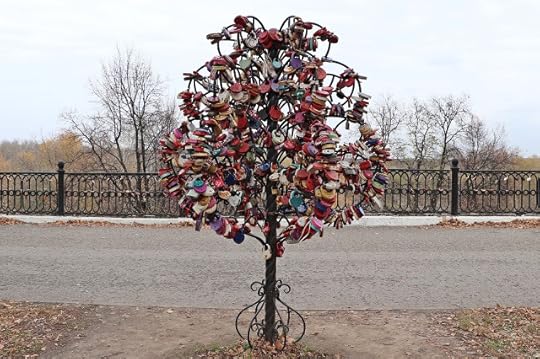
It turns out, lots of people are die-hard romantics. Currently, of course, many people are still at home right now to stay safe during this pandemic. Cities that are normally bustling with tourists are quiet and empty of visitors…but one day people will fill the squares and the streets again. And when they do, this tradition will no doubt continue. Love locks have secured their place in people’s hearts.

Paris on Repeat
By Amy Bearce

Groundhog Day gets a hilarious French twist in this delightful upper middle grade novel about first crushes and friendship when an eighth-grade class trip to Paris goes horribly wrong and the worst day of one girl’s life keeps happening over and over.
Fourteen-year-old Eve Hollis is ready to push through her fears and finally let her crush know how she feels. And what better place to tell him than on top of the Eiffel Tower in the City of Love? But things don’t go as planned, and Eve is sure she’s had the worst day of her life— until she wakes up the next morning to realize the whole disaster of a day is happening again. She’s trapped in a time loop.
Desperate to make it stop, Eve will have to take some big risks and learn from her mistakes or she’s destined to live the most awkwardly painful day of her life over and over again, forever.
Pick up your copy of
Paris on Repeat
Jolly Fish Press • IndieBound • Barnes and Noble • Amazon
Amy Bearce

You can learn more about Amy and her books at www.amybearce.com
The Coffee Pot Book Club
...more
- Mary Anne Yarde's profile
- 159 followers



